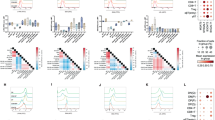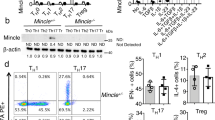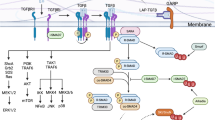Abstract
Regulated glycosylation controls T cell processes, including activation, differentiation and homing by creating or masking ligands for endogenous lectins. Here we show that stimuli promoting T helper type 1 (TH1), TH2 or interleukin 17–producing T helper (TH-17) differentiation can differentially regulate the glycosylation pattern of T helper cells and modulate their susceptibility to galectin-1, a glycan-binding protein with anti-inflammatory activity. Although TH1- and TH-17–differentiated cells expressed the repertoire of cell surface glycans critical for galectin-1–induced cell death, TH2 cells were protected from galectin-1 through differential sialylation of cell surface glycoproteins. Consistent with those findings, galectin-1–deficient mice developed greater TH1 and TH-17 responses and enhanced susceptibility to autoimmune neuroinflammation. Our findings identify a molecular link among differential glycosylation of T helper cells, susceptibility to cell death and termination of the inflammatory response.
This is a preview of subscription content, access via your institution
Access options
Subscribe to this journal
Receive 12 print issues and online access
$209.00 per year
only $17.42 per issue
Buy this article
- Purchase on Springer Link
- Instant access to full article PDF
Prices may be subject to local taxes which are calculated during checkout








Similar content being viewed by others
References
Coffman, R.L. Origins of the TH1-TH2 model: a personal perspective. Nat. Immunol. 7, 539–541 (2006).
Bettelli, E., Oukka, M. & Kuchroo, V.K. TH-17 cells in the circle of immunity and autoimmunity. Nat. Immunol. 8, 345–350 (2007).
Steinman, L. A brief history of TH-17, the first major revision in the TH1/TH2 hypothesis of T cell-mediated tissue damage. Nat. Med. 13, 139–145 (2007).
Glimcher, L.H. & Murphy, K.M. Lineage commitment in the immune system: the T helper lymphocyte grows up. Genes Dev. 14, 1693–1711 (2000).
Langrish, C.L. et al. IL-23 drives a pathogenic T cell population that induces autoimmune inflammation. J. Exp. Med. 201, 233–240 (2005).
Harrington, L.E. et al. Interleukin 17–producing CD4+ effector T cells develop via a lineage distinct from the T helper type 1 and 2 lineages. Nat. Immunol. 6, 1123–1132 (2005).
Park, H. et al. A distinct lineage of CD4 T cells regulates tissue inflammation by producing interleukin 17. Nat. Immunol. 6, 1133–1141 (2005).
Bettelli, E. et al. Reciprocal developmental pathways for the generation of pathogenic effector TH-17 and regulatory T cells. Nature 441, 235–238 (2006).
Veldhoen, M., Hocking, R.J., Flavell, R.A. & Stockinger, B. Signals mediated by transforming growth factor-β initiate autoimmune encephalomyelitis, but chronic inflammation is needed to sustain disease. Nat. Immunol. 7, 1151–1156 (2006).
Mangan, P.R. et al. Transforming growth factor-β induces development of the TH-17 lineage. Nature 441, 231–234 (2006).
Ivanov, I.I. et al. The orphan nuclear receptor RORγt directs the differentiation program of proinflammatory IL-17+ T helper cells. Cell 126, 1121–1133 (2006).
Daniels, M.A., Hogquist, K.A. & Jameson, S.C. Sweet 'n' sour: the impact of differential glycosylation on T cell responses. Nat. Immunol. 3, 903–910 (2002).
Demetriou, M., Granovsky, M., Quaggin, S. & Dennis, J.W. Negative regulation of T cell activation and autoimmunity by Mgat5 N-glycosylation. Nature 409, 733–739 (2001).
Comelli, E.M. et al. Activation of murine CD4+ and CD8+ T lymphocytes leads to dramatic remodeling of N-linked glycans. J. Immunol. 177, 2431–2440 (2006).
Morgan, R. et al. N-acetylglucosaminyltransferase V (Mgat5)-mediated N-glycosylation negatively regulates Th1 cytokine production by T cells. J. Immunol. 173, 7200–7208 (2004).
Lim, Y.C. et al. IL-12, STAT4-dependent up-regulation of CD4+ T cell core 2 β-1,6-N-acetylglucosaminyltransferase, an enzyme essential for biosynthesis of P-selectin ligands. J. Immunol. 167, 4476–4484 (2001).
Underhill, G.H. et al. A crucial role for T-bet in selectin ligand expression in T helper 1 (Th1) cells. Blood 106, 3867–3873 (2005).
Mitoma, J. et al. Critical functions of N-glycans in L-selectin-mediated lymphocyte homing and recruitment. Nat. Immunol. 8, 409–418 (2007).
Chen, G.Y., Osada, H., Santamaria-Babi, L.F. & Kannagi, R. Interaction of GATA-3/T-bet transcription factors regulates expression of sialyl Lewis X homing receptors on Th1/Th2 lymphocytes. Proc. Natl. Acad. Sci. USA 103, 16894–16899 (2006).
Gabius, H.J. Cell surface glycans: the why and how of their functionality as biochemical signals in lectin-mediated information transfer. Crit. Rev. Immunol. 26, 43–79 (2006).
van Vliet, S.J., Gringhuis, S.I., Geijtenbeek, T.B. & van Kooyk, Y. Regulation of effector T cells by antigen-presenting cells via interaction of the C-type lectin MGL with CD45. Nat. Immunol. 7, 1200–1208 (2006).
Rabinovich, G.A. et al. Galectins and their ligands: amplifiers, silencers or tuners of the inflammatory response? Trends Immunol. 23, 313–320 (2002).
Perillo, N.L., Pace, K.E., Seilhamer, J.J. & Baum, L.G. Apoptosis of T cells mediated by galectin-1. Nature 378, 736–739 (1995).
Garin, M.I. et al. Galectin-1: a key effector of regulation mediated by CD4+ CD25+ T cells. Blood 109, 2058–2065 (2007).
Rabinovich, G.A. et al. Recombinant galectin-1 and its genetic delivery suppress collagen-induced arthritis via T cell apoptosis. J. Exp. Med. 190, 385–398 (1999).
Santucci, L. et al. Galectin-1 suppresses experimental colitis in mice. Gastroenterology 124, 1381–1394 (2003).
Offner, H. et al. Recombinant human β-galactoside binding lectin suppresses clinical and histological signs of experimental autoimmune encephalomyelitis. J. Neuroimmunol. 28, 177–184 (1990).
Rubinstein, N. et al. Targeted inhibition of galectin-1 gene expression in tumor cells results in heightened T cell-mediated rejection; A potential mechanism of tumor-immune privilege. Cancer Cell 5, 241–251 (2004).
Hannier, S., Bitegye, C. & Demotz, S. Early events of TCR signaling are distinct in human Th1 and Th2 cells. J. Immunol. 169, 1904–1911 (2002).
Stillman, B.N. et al. Galectin-3 and galectin-1 bind distinct cell surface glycoprotein receptors to induce T cell death. J. Immunol. 176, 778–789 (2006).
Hirabayashi, J. et al. Oligosaccharide specificity of galectins: a search by frontal affinity chromatography. Biochim. Biophys. Acta 1572, 232–254 (2002).
Stowell, S.R. et al. Human galectin-1 recognition of poly-N-acetyllactosamine and chimeric polysaccharides. Glycobiology 14, 157–167 (2004).
Galvan, M., Tsuboi, S., Fukuda, M. & Baum, L.G. Expression of a specific glycosyltransferase enzyme regulates T cell death mediated by galectin-1. J. Biol. Chem. 275, 16730–16737 (2000).
Priatel, J.J. et al. The ST3Gal-I sialyltransferase controls CD8+ T lymphocyte homeostasis by modulating O-glycan biosynthesis. Immunity 12, 273–283 (2000).
Amano, M., Galvan, M., He, J. & Baum, L.G. The ST6Gal I sialyltransferase selectively modifies N-glycans on CD45 to negatively regulate galectin-1-induced CD45 clustering, phosphatase modulation and T cell death. J. Biol. Chem. 278, 7469–7475 (2003).
Grabie, N. et al. β-galactoside α2,3-sialyltransferase-I gene expression during Th2 but not Th1 differentiation: implications for core2-glycan formation on cell surface proteins. Eur. J. Immunol. 32, 2766–2772 (2002).
Cervi, L., MacDonald, A.S., Kane, C., Dzierszinski, F. & Pearce, E.J. Cutting edge: dendritic cells copulsed with microbial and helminth antigens undergo modified maturation, segregate the antigens to distinct intracellular compartments, and concurrently induce microbe-specific Th1 and helminth-specific Th2 responses. J. Immunol. 172, 2016–2020 (2004).
Pulendran, B. Modulating TH1/TH2 responses with microbes, dendritic cells, and pathogen recognition receptors. Immunol. Res. 29, 187–196 (2004).
Zhu, C. et al. The Tim-3 ligand galectin-9 negatively regulates T helper type 1 immunity. Nat. Immunol. 6, 1245–1252 (2005).
Lenardo, M. et al. Mature T lymphocyte apoptosis–immune regulation in a dynamic and unpredictable antigenic environment. Annu. Rev. Immunol. 17, 221–253 (1999).
Zhang, X. et al. Unequal death in T helper cell (Th)1 and Th2 effectors: Th1, but not Th2, effectors undergo rapid Fas/FasL-mediated apoptosis. J. Exp. Med. 185, 1837–1849 (1997).
Blaser, C. et al. β-galactoside-binding protein secreted by activated T cells inhibits antigen-induced proliferation of T cells. Eur. J. Immunol. 28, 2311–2319 (1998).
Chui, D. et al. Genetic remodeling of protein glycosylation in vivo induces autoimmune disease. Proc. Natl. Acad. Sci. USA 98, 1142–1147 (2001).
Daniels, M.A. et al. CD8 binding to MHC class I molecules is influenced by T cell maturation and glycosylation. Immunity 15, 1051–1061 (2001).
Jenner, J., Kerst, G., Handgretinger, R. & Müller, I. Increased α2,6-sialylation of surface proteins on tolerogenic, immature dendritic cells and regulatory T cells. Exp. Hematol. 34, 1212–1218 (2006).
Brennan, P.J. et al. Sialylation regulates peripheral tolerance in CD4+ T cells. Int. Immunol. 18, 627–635 (2006).
Kaneko, Y., Nimmerjahn, F. & Ravetch, J.V. Anti-inflammatory activity of immunoglobulin G resulting from Fc sialylation. Science 313, 670–673 (2006).
van der Leij, J. et al. Strongly enhanced IL-10 production using stable galectin-1 homodimers. Mol. Immunol. 44, 506–513 (2007).
Vespa, G.N. et al. Galectin-1 specifically modulates TCR signals to enhance TCR apoptosis but inhibits IL-2 production and proliferation. J. Immunol. 162, 799–806 (1999).
Stumhofer, J.S. et al. Interleukin 27 negatively regulates the development of interleukin 17-producing T helper cells during chronic inflammation of the central nervous system. Nat. Immunol. 7, 937–945 (2006).
Laurence, A. et al. Interleukin-2 signaling via STAT5 constrains T helper 17 cell generation. Immunity 26, 371–381 (2007).
Poirier, F. & Robertson, E.J. Normal development of mice carrying a null mutation in the gene encoding the L14 S-type lectin. Development 119, 1229–1236 (1993).
Acknowledgements
We thank H. Rosenberg for critical reading of the manuscript; J. Hirabayashi, K.I Kasai and F.T. Liu for plasmids; C. Stanley, L. Campagna, M. Barboza, M. Vermeulen and the staff of the Animal Facility (Facultad de Ciencias Exactas y Naturales, University of Buenos Aires) for technical assistance; and G. Vasta, L. Steinman, M. Lenardo, L. Glimcher, R. Schreiber, C. Weaver, N. Rubinstein, L. Fainboim and J. Geffner for comments or advice. Rabbit antiserum to ST6Gal1 was from K. Colley (University of Illinois, Chicago) and endotoxin-free SEA was from M. Doenhoff (University of Wales). Supported by the Cancer Research Institute (G.A.R.), the Mizutani Foundation for Glycoscience (G.A.R.), the Sales Foundation (G.A.R.), the National Agency for Promotion of Science and Technology (G.A.R.), the Wellcome Trust (G.A.R. and E.M.R.), the University of Buenos Aires (G.A.R.), the Bunge & Born Foundation (G.A.R.), the Fiorini Foundation (G.A.R.), the National Institutes of Health (L.G.B. and J.D.H.), Ligue Contre le Cancer (F.P.), the John Simon Guggenheim Memorial Foundation (G.A.R.) and The National Research Council for Scientific and Technical Investigations (G.A.R. and N.W.Z.).
Author information
Authors and Affiliations
Contributions
M.A.T. designed and did experiments and contributed to manuscript preparation; G.A.B. and J.M.I. designed and did experiments; D.O.C. assisted with histological data; J.C. assisted with EAE experiments; F.P. provided Lgals1−/− mice and advice; N.W.Z., J.D.H., L.G.B. and E.M.R. contributed reagents and to the design of experiments and writing of the manuscript; and G.A.R. conceptualized and supervised the work, designed the experiments and wrote the manuscript.
Corresponding author
Ethics declarations
Competing interests
The authors declare no competing financial interests.
Supplementary information
Supplementary Text and Figures
Supplementary Figures 1–6 and Supplementary Table 1 (PDF 1347 kb)
Rights and permissions
About this article
Cite this article
Toscano, M., Bianco, G., Ilarregui, J. et al. Differential glycosylation of TH1, TH2 and TH-17 effector cells selectively regulates susceptibility to cell death. Nat Immunol 8, 825–834 (2007). https://doi.org/10.1038/ni1482
Received:
Accepted:
Published:
Issue Date:
DOI: https://doi.org/10.1038/ni1482
This article is cited by
-
Membrane organization by tetraspanins and galectins shapes lymphocyte function
Nature Reviews Immunology (2023)
-
Targeting galectin-driven regulatory circuits in cancer and fibrosis
Nature Reviews Drug Discovery (2023)
-
Immune regulatory networks coordinated by glycans and glycan-binding proteins in autoimmunity and infection
Cellular & Molecular Immunology (2023)
-
The role of galectins in immunity and infection
Nature Reviews Immunology (2023)
-
Mannosylated glycans impair normal T-cell development by reprogramming commitment and repertoire diversity
Cellular & Molecular Immunology (2023)



